Hans Walter Gabler (University of Munich)
Computer-aided critical edition of Ulysses
Abstract
Work is in progress at the University of Munich (Germany) on
a critical edition of Ulysses (1922) by James Joyce for
which TUSTEP, the standard system of computer programs for
text processing written by Wilhelm Ott and his group in
Tübingen, is being used. Given a complex and richly
documented pre-publication history, computer processing
ensures the highest possible degree of completeness and
accuracy in the recording, collation, and presentation of
the extant textual materials. Among the available programs
are a text editor, and collation, correction, copying,
index-sorting, and type-setting programs. The methods of
their use for this project have been developed in a pilot
project for the editing and book production of a single
chapter. The editorial result comprises a clear reading text
and a synopsis of the pre- and post-publication evolution of
the author's text on facing pages. Historical Collation and
Emendations lists are given in an appendix.
Work is in progress at the University of Munich (Germany) on a critical edition of Ulysses (1922). As a technical and procedural resource, the TUSTEP system of computer programs for text processing which has been developed at the computing centre of the University of Tübingen, is being employed. It operates on the Konstanz TR440 computer. The Ulysses edition is a first step towards a complete critical edition of the works of James Joyce.
Principles of present-day editorial theory and practice in Anglo-American and German textual scholarship form the rationale for the edition which in itself does not depend on the computer for its realisation. Yet, in practical terms, computer processing ensures the highest possible degree of completeness and accuracy in the recording, collating, and presentation of the vast volume of its textual material. While in no way impairing the critical quality of the editorial activity, the computer processing organizes the editorial procedures by adapting them to the handling facilities of the TUSTEP system. We wish to describe how, in a given textual situation, this well co-ordinated standard system of text processing and printing programs may be successfully employed in the services of scholarly textual editing.
I. The Textual Situation
Following a preparatory period of several years from which no textual record survives, Ulysses began to be written, chapter by chapter, in late 1917. The final chapter in the order of composition (the penultimate one of the novel's eighteen chapters) was concluded in manuscript in October 1921. From drafts, of which only a few survive, each chapter reached a state of consolidation in a final working draft. Thereafter, the chapters were to remain essentially unaffected in structure by even the most copious subsequent verbal revision and expansion. The final working drafts are lost for all but three chapters. From each of them as it was ready, though not from the three surviving ones, a holograph fair copy was prepared. Fifteen chapters in fair copy and three in final working draft state form what is today known as the Rosenbach Manuscript (R) of Ulysses.
When a chapter had reached the R state, a typescript (T) was soon made. For a total of nine chapters this was copied from R, while for the other nine it was typed from the final working draft (W) at a stage of revision beyond that at which it had been authorially copied into R. Thus, R stands outside the direct line of transmission for half of the novel's chapters. Yet by this very circumstance it becomes possible to reconstruct lost W for these chapters, and to distinguish its basic text and post-R revisions, from the combined evidence of its radiating derivatives R and T.
Though it happens to be lost for the first five chapters, T is the essential link in the text's transmission from manuscript to print. It served throughout (though in different exemplars) as printer's copy: first, in an exemplar that does not survive, for the 'work in progress' serialization of fourteen chapters in the New York/Chicago Little Review (L) (March 1918 to September/December 1920), with parallel excerpts in the London Egoist (E); and then for the complete Paris book publication of 1922.
Joyce revised and expanded the novel's text, in multiple holograph overlay to T and the series of up to nine successive proof stages of the book publication, by altogether about a third over the state of R, or reconstructed W. The cumulation of holograph notation from W/R to the last additions to each final proof may be defined as a continuous manuscript of the novel. This multi-layered continuous manuscript is documented in, or, as in the case of the several brief and clearly defined lacunae in the transmission, it is recoverable from, the range of the extant textual witnesses, R, T, L/E, and the successive book publication proofs.
The critical edition's reading text is established on the
basis of the edited continuous manuscript. The appended
Historical Collation and Emendations lists record where the
first and subsequent book publications deviate from the
edition text, and where the edition text itself results from
critical emendation of the continuous manuscript text. In
addition, the continuous manuscript accompanies the reading
text as a synoptic display apparatus of the textual development.
A trial edition of the novel's eighth chapter has already
been completed and is shown in
Figures 1 and 2. The reading
text appears in Figure 2. In Figure 1, it is accompanied by
the synoptic display of the growth of the text from final
authorial manuscript draft (in this case, the earliest
genetic stage recovered as no preliminary drafts of the
chapter survive) up to the first book publication of 1922,
with a system of superimposed diacritics to indicate the
text's predominantly accretive development. Pairs of carets
enclose revision within a document. The opening carets
rotate clockwise (and the closing ones anti-clockwise
correspondingly) where there is more than one such level of
revision. Alphanumeric indices in opening and closing
halfbrackets delimit the extension of manuscript additions
and revisions to typescript and successive sets of proofs.
Pointed brackets enclose deletions within a given stage of textual
development: they indicate immediate or early deletion of
textual elements as operations occurring in one document.
Square brackets invalidate, at the genetic stage indexed,
text that was valid up to the preceding stage: they indicate
where text of one document, often transmitted through
several witnesses, is removed, and frequently replaced, in a
later document.
II. The Input
The OCR-A input, totalling about a million words, consists
of transcripts in full of R, of the basic typed text of T
(or, where this is missing, the initial typesetting of the
book publication proofs (P)), and further of L, of E, of the
1922 first edition (22) and the 1926 second edition (26);
lastly, of all holograph overlay only from T and the
successive book publication proofs.
The multiple input serves initially to obtain error-free
computer records of the textual data. The variation revealed
in a preparatory series of machine collations is checked
back against the documents transcribed, and all input error
is eliminated by file corrections carried out by hand at the
computer terminal, or automatically with the program
TXTKORRIGIERE. The data checks operate and interact as follows.
R is computer-filed with full caret coding of its
intra-linear, interlinear, and marginal revisions. To avoid
compounding input error with misreadings of the manuscript,
the input is first controlled by triple independent eye
collation of the OCR transcript before computer collation
with T. The input of T in its turn requires throughout a
check independent of its collation run against R, and
especially so where it derives not from R, but radiates with
R from W and thus possesses a higher degree of primary
authority as a textual witness. Hence, L (and E) serve as
double input for T, and are machine-collated with it. As
edition material subsequently to be utilized, the early
authorial revisions made immediately on completion of each
chapter typescript, i.e. before its serialization, can be
isolated on the basis of the evidence of L and E from the
total holograph overlay of the extant T exemplar (which was
the printer's copy for 22). In addition, occasional further
authorial revisions are recoverable from L. These appear
inadvertently to have been entered only on the lost exemplar
of T which was used as its printer's copy. For the text of
lost sections of T, the input of its parallel derivations L
and P serve as double evidence. Finally, a strictly verbatim
and literatim record of 22 is ascertained by using the
full transcript of the fresh typesetting of 26 as double
input. Besides revealing the 22 and 26 input errors, this
yields the true 22:26 variation, from which a small number
of post-publication authorial revisions can be culled.
III. The Editing
1. Establishing an Early-Version Sub-Edition
The author's commissioning of T, and the serialized
publication of fourteen chapters of the novel from an only
slightly revised exemplar of it, marks a recognisable point
of incision in the continuous textual development. This
justifies, and the shifting stemmatic relationship of R and
T positively requires, an early-version text as an initial
auxiliary sub-edition in the editing process. Established
from the combined evidence of R, T, L/E [and P], this
provides an ideal
text corresponding to the stage of textual development
reached with the revision of T in preparation for the
serialization (or, in the case of the last four chapters,
for the initial book typesetting), but free from the
authorial fair-copying mistakes of R, the typist's
mistypings of T, and the compositorial errors of L/E and P.
Recorded with all necessary coding to indicate the stages of
textual growth it covers, as well as all emendation required
to eliminate actual corruption from the document
representation of the continuous manuscript text, this
sub-edition F (for German 'Frühtext') is established with R
as its copy-text.
The automatized editing of F begins with a series of
parallel machine collations, all based on R and keyed to it
as the collation base text. The collations are R:T, R:L,
where possible R:E, and where necessary (in the absence of
T), R:P. The program TXTVERGLEICH files each batch of
variants separately and tags them all for sorting. By one of
several available parameters, it formats the collation
result as '[base text reading] variant' for each entry.
The sorting reference provided by TXTVERGLEICH permits the
use of the program TXTVDRUCKE to print out a synoptic
display in parallel lines of the entire variation among the
witnesses collated as a first aid to the critical editing as
shown in Figure 3. A second aid is provided by printouts of
the collation files for pre-marking the editorial decisions
as facilitated by the synoptic display
(Figure 4). Each
variant is labelled as either a genetic variant (an
authorial revision or addition), an authorial correction of
an earlier error in the autograph notation, a transmissional
variant to be admitted into the critically established text
(e.g. a full stop at the end of a paragraph in T where Joyce
in his speedy inscription of R omitted it), or a
transmissional variant to be rejected or filed away in
preparation for the Historical Collation list (e.g.
mistypings in T, many of which survive into L, or 22).
The markings are transferred to the actual collation files
at the terminal. The group of genetic variants from each
file, already formatted as '[base text reading] variant',
are first extracted to be provided automatically with the
opening and closing symbols for the diacritics to indicate
the genetic stage of the textual change, and are then all
collected in one new file. To this are added the emendation
variants, for which the '[base text reading]' is
automatically reformatted into an emendation note appended
to the emended reading. Within bracketing symbols, this
gives the document code for the source of the emendation,
and the rejected reading with its source code. Thus
10817.32,8(T)[nook]=nook.
becomes
10817.32,8=nook.&*T;nookR*&
The string of characters between the brackets &* and *&, by
which the critically established reading appears extended,
is carried through all subsequent computing operations. In
the end, supplied with its current reference, it is
bracketed off into the Emendations list. Purely editorial
emendations unsupported by a source document are
hand-supplied in the same format. All material so collected
is sorted in rising sequence of the base text reference. The
subsequent program TXTKORRIGIERE interprets the entry
references by their tags of =, +, or - as instructions to
update the base text R: the combined file thus constitutes a
correction file to convert a copy of R into F, the ideal
early version text
critically constituted and diacritically stratified to
represent the textual growth from W to (ideal) L as shown in
Figure 5. A convenient check on the resulting edited text is
possible by generating a clear text FC from F, employing the
particularly versatile program TXTKOPIERE to exclude all
bracketed material, i.e. text genetically superseded, to
eliminate all diacritics, and to close up
(Figure 6), then
running a new series of collations from FC as collation base
text with, in turn, R, T, L, E, and P. The synoptic display
in parallel lines quickly reveals infelicitous or
inconsistent editorial decisions. If a separate
presentation, e.g. publication, of Ulysses in its ideal
early version text is desired, a full variants list of the
documents from which it was constituted can be automatically
established from the same collation material.
2. Integrating the Continuous Manuscript Text
From F, which represents the initial phases of the novel's
textual development, the text attains its full extension by
expanding over the post-early-version authorial revisions
and additions into a completeness corresponding to the 1922
book edition. Yet the computer-assisted editing cannot
easily build up the continuous manuscript in the sequential
manner of its growth. Since with each level of revision and
accretion the text moves one step further away from F, F
cannot act as the basic frame of reference necessary for
co-ordinated computer operations. 22 on the other hand,
though in its actual state it abounds in the corruptions
which the critical edition endeavours to eradicate,
constitutes the fullest extant version of the novel's text
and can therefore provide the reference framework needed.
Fundamentally, the editing may be seen to proceed as a
grafting of the critical text onto the physical frame of the
actual 1922 first edition text in its computer-file form. In
the course of the grafting, every element in the verbatim
and literatim record of 22 is eliminated or exchanged,
if it does not conform to the continuous manuscript text as
critically established with a full record of the textual
growth. To obtain the several sections of the critical
edition, the computer file of 22 is doubled into the graft
copy (22G), and a second copy (22U) where the text is left
untouched. In 22U, every element which has been exchanged,
expanded, or eliminated in 22G is automatically marked to
indicate the place and time of entry into the transmission
of the deviation from the continuous manuscript it
represents. Transmissional variants editorially accepted
from 22 are similarly labelled. At the conclusion of the
editing process, this will permit a simple computer
collation of the critically established reading text against
22U to generate the Historical Collation list automatically.
To integrate the continuous manuscript text in the graft
copy, the post-early-version levels of the novel's revision
and accretion are pieced together from the authorial overlay
only of the typescript and the successive book publication
proofs. The holograph material is transcribed and assembled
into lists by source document. For the purposes of the
subsequent processing, each entry in the assembly of each
list is defined as an addition to the last preceding
invariant word by the page/line/word number of that word in
22. Every instance of authorial change is registered, except
for simple corrections of transmissional errors that fully
restore readings preserved in the autograph inscription of a
preceding witness. To guard against oversights and
misreadings of Joyce's handwriting, the assembled material
is twice eye-collated back against its source before input
via OCR. In the computer, the entries of each list as a
whole are automatically supplied with the symbols for the
opening and closing diacritics which are to
delimit them in the integrated synoptic text. Thereafter,
utilizing the hand-supplied common system of reference, the
individual lists are fused and sequentially sorted into one
cumulative list (List I) (Figure 7).
As a parallel operation, FC, the early version clear text,
is collated against basic 22, producing as List II the
actual FC:22 difference in bulk (Figure 8).
An additional parameter of the collation program TXTVERGLEICH
automatically generates the 22 p/1/w reference of each
instance of variation. Ideally, List II should be textually
identical with the cumulative holograph overlay assembled in
List I. In fact. List I may contain authorial revisions
overlooked by the book compositors. More importantly, List
II exceeds List I in all instances of transmissional
variation affecting the early-version portion of 22. These
are traced to their source (a majority are usually already
accounted for among the group of transmissional typescript
variants rejected in establishing F) and are subfiled, with
a view to correcting 22G and, in complementary form, to
label the basic readings in question in 22U.
Each entry in List II as reduced by the instances of
transmissional error so treated now corresponds to an entry,
or a group of successive entries, in List I. By means of the
22 references present in both lists (hand-supplied in List
I, and generated automatically in List II) the lists may be
combined and the entries sequentially sorted into List III
(Figure 9). In III, the textually corresponding entries from
I and II should appear grouped together. Where they do not
so appear, an error in the hand-supplied reference of List I
needs correction, or else a compositorial misplacing of an
authorial revision in the published 22 text is revealed. The
grouped double entries in III are formatted as hand-supplied
reference (rh) with text transcribed from holograph
(th) from List I, and automatically generated
reference (ra ) and text (ta) from List
II. Processing with TXTKOPIERE combines ra with
th, and eliminates rh and ta.
The resulting correction file, expanded by the sub-file of
transmissional variant corrections and emendations already
prepared, converts a copy of 22 into a first version of 22G,
the graft copy (Figure 10).
In 22G, all post-early-version text is now contained not in
the form of the 1922 publication, but in that of the
editorial transcription of the holograph overlay in the
pre-publication documents, emended and correctly stratified
genetically by means of the automatically supplied diacritic
code symbols of List I. 22G is also correct as a clear text
in its early-version portion. But the full early-version
genetic material and stratification symbols remain to be
introduced, and the hand-compiled text from List I needs a
machine collation to eliminate errors of the OCR
transcription, and to locate transmissional variation in the
post-early-version sections of published 22. To automate
both operations, 22G is re-lined so that lines or units of
lines of post-early-version text alternate with lines or
units of lines of early-version text
(Figure 11). Thus
re-formatted, 22G as a whole is collated against base text
22; or, since textually this amounts to the same thing,
against 22U with the transmissional variants in its early
version portion already labelled. The collations for the
early version sections are discarded, since they simply
represent once more the transmissional variants already
rejected. Following a collation against 22U, this can be
done automatically by instructing TXTKOPIERE to eliminate
all textual units containing a 22U labelling symbol. From
the collation result as it refers to the post-early-version
sections of 22G, the input errors (OCR mistypings as well as
possible misreadings of Joyce's holograph revisions) are
extracted into the first part of a correction file to update
re-lined 22G. The transmissional variants
revealed in the published 22 text are traced to their
respective documents of origin and are formatted into a
supplementary correction file to mark up 22U. To introduce
the genetic stratification of F into 22G, the early-version
sections only of 22G are extracted, preserving their lining
and line numbering. A collation of this extract against F
produces the second part of the correction file to update
re-lined 22G.
The first and the second part of the correction file
combined convert 22G into the fully edited and genetically
stratified text, which may now be re-paginated and re-lined
as desired. Thereafter, the occasional introduction of the
few post-publication authorial revisions revealed in
collations of the 1926, 1932, and 1936 editions of Ulysses
complete the critically established synopsis of the novel's
textual growth. From it, the Emendations list is separated
and the edition's clear reading text is automatically
generated. A collation of the clear text against 22U
provides the Historical Collation list
(Figure 12). The
edition's several sections are processed through the
typesetting programs of TUSTEP into book publication format.
Figure 1: Synoptic Text
Figure 2: Clear Reading Text
back to the text
Figure 3: Parallel Line Printout of R, T, and L
back to the text
Figure 4: Collation [R] T and Collation [R] L
back to the text
Figure 5: F
back to the text
Figure 6: FC
back to the text
Figure 7: List I
back to the text
Figure 8: List II
back to the text
Figure 9: List III
back to the text
Figure 10: Correction File to Obtain 22G, First Version
back to the text
Figure 11: 22G Lined to Separate Units of
Post-Early-Version Text and Early-Version Text
back to the text
Figure 12: Historical Collation
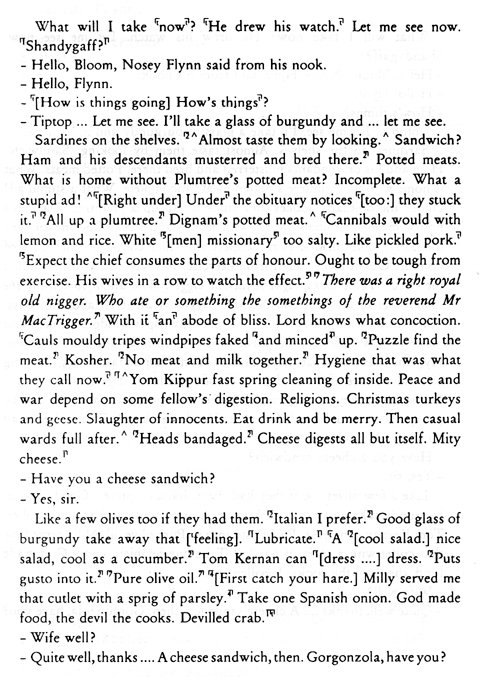
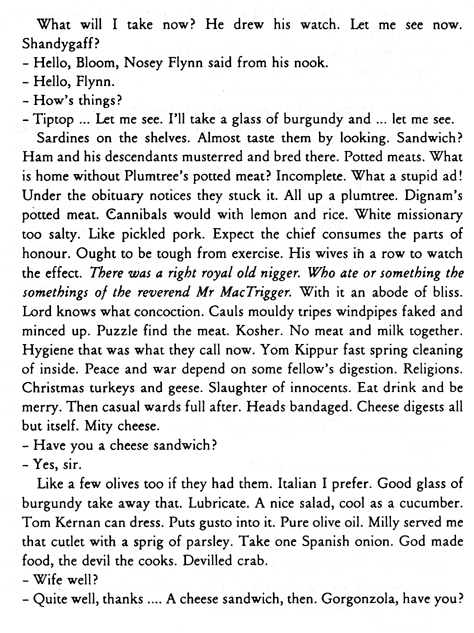
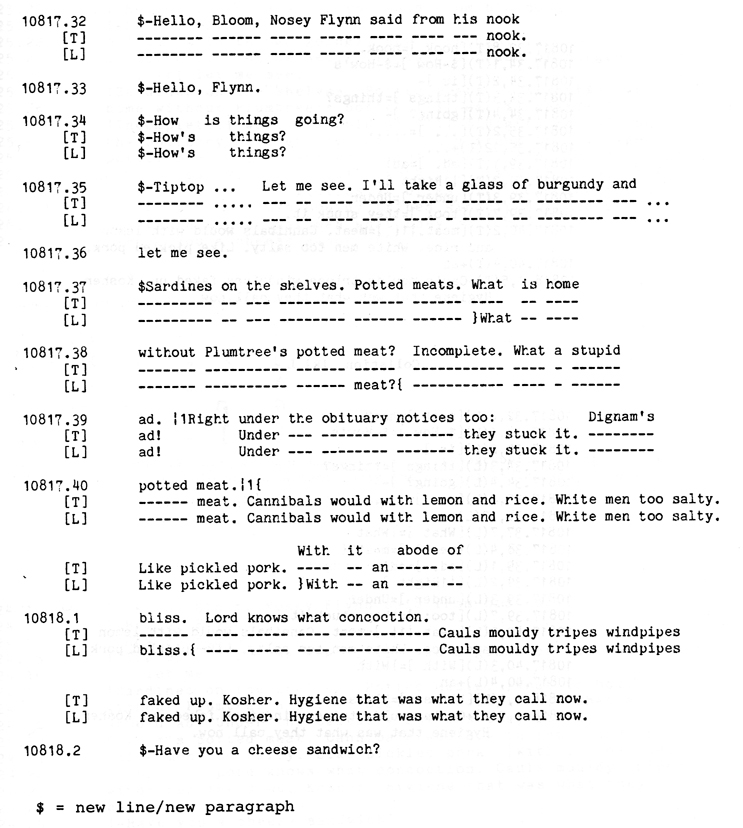
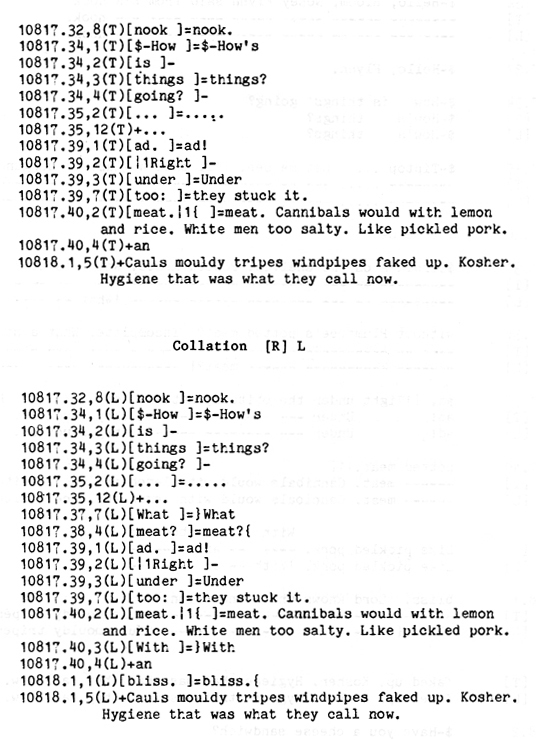
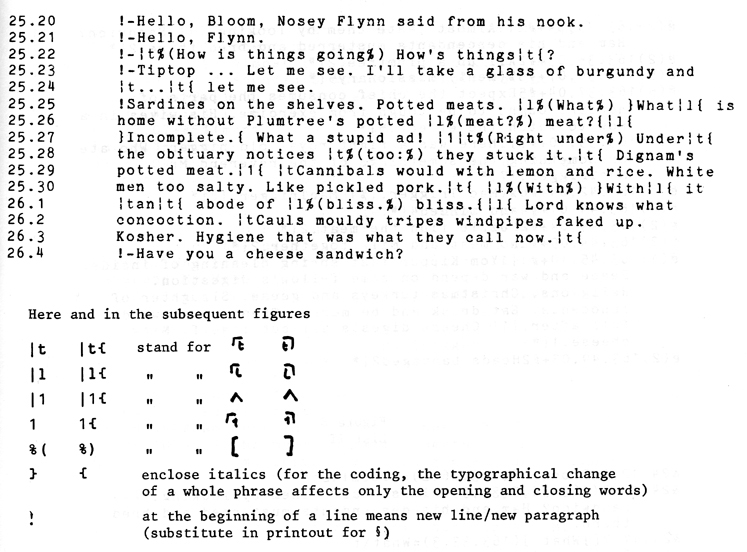
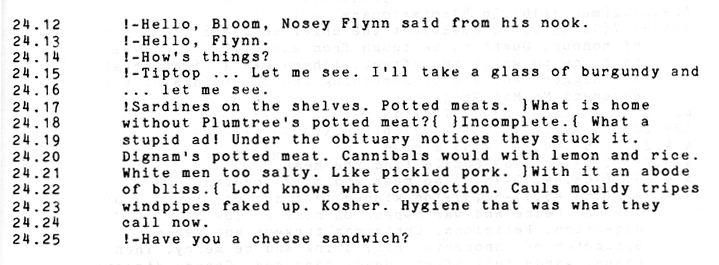
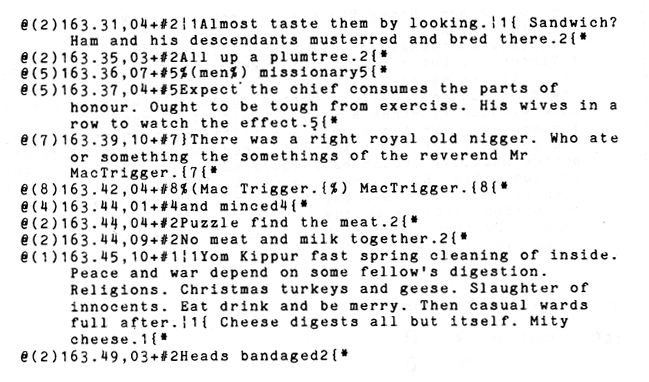
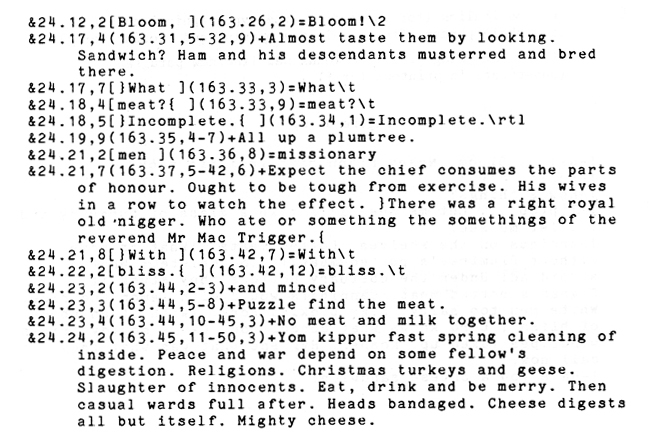
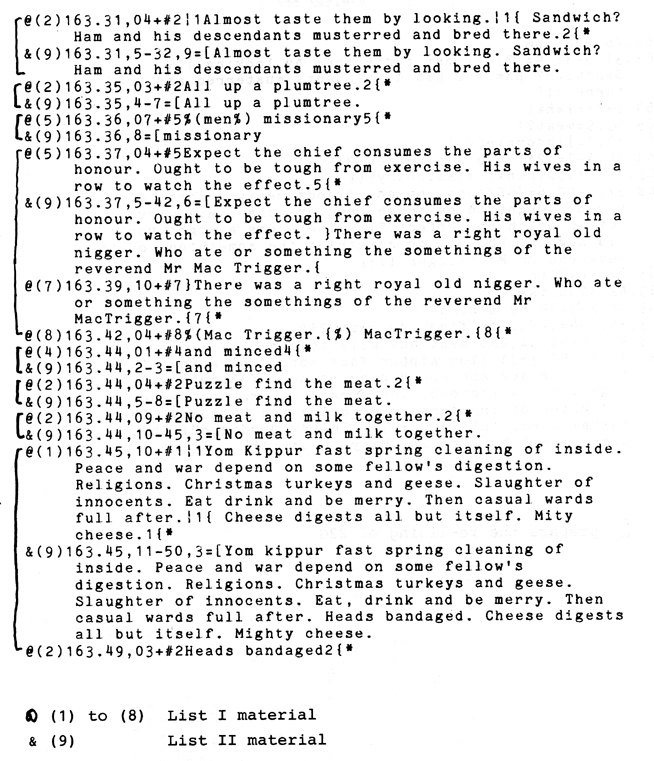
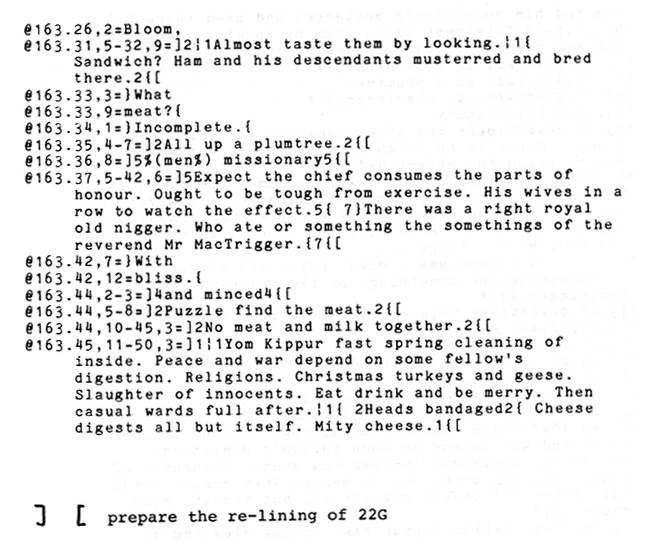
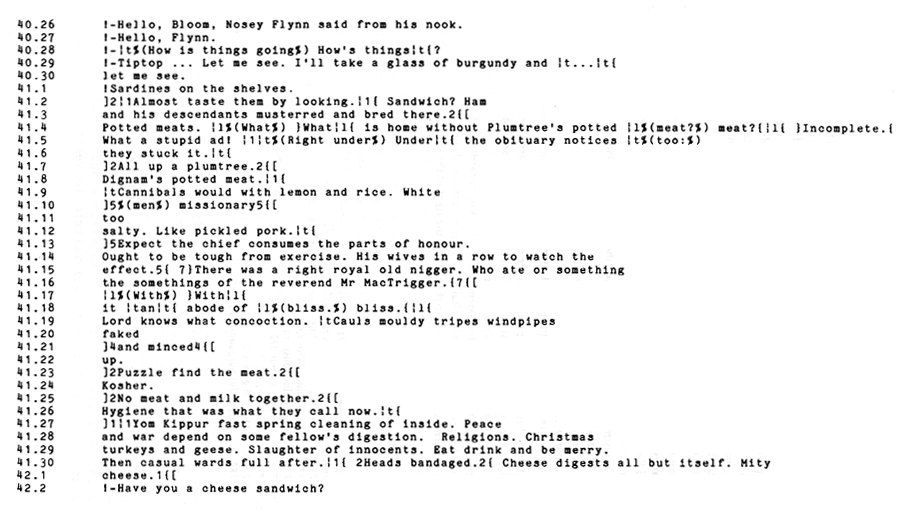
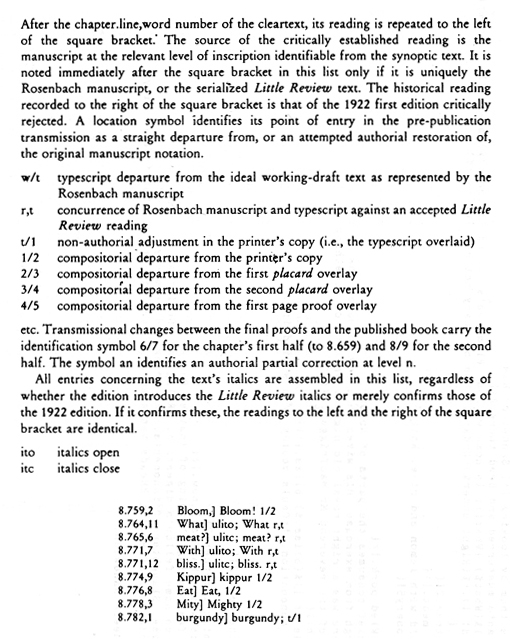
Zur
Übersicht über die bisherigen Kolloquien
tustep@zdv.uni-tuebingen.de - Stand: 29. April 2002
